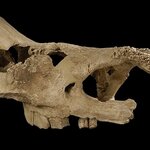Paleontology

Dinosaur hunters on a month-long expedition to the Sahara desert have returned home in time for Christmas with more than they ever dreamed of finding.
They have unearthed not one but two possible new species of extinct animals. Their success marks one of the most exciting discoveries to come out of Africa for 50 years.
The team have discovered what appears to be a new type of pterosaur and a previously unknown sauropod, a species of giant plant-eating dinosaur. Both would have lived almost one hundred million years ago.
The palaeontologists discovered a large fragment of…

Dinosound revival is no kidding to me. I was at the foothills of tall snow-capped mountains by the sea when this happened. A very loud sound filled the meadows and startled my senses like a dinosaur call! Well, it happened again, the next day about the same time, just before the sunset and for several minutes. I had to inquire swiftly for a local answer.
Come on, did you just accept that we know the sounds of an animal that lived long before even a woman was on the world scene? I mean, did the dinosaurs bark or tweet, scream, hiss, roar, coo, neigh or sing?
Source: Parasaurolophus…

It is widely accepted that Upper Paleolithic early modern humans spread westward across Europe about 42,000 years ago, variably displacing and absorbing Neandertal (alt. spelling Neanderthal) populations in the process. However, Middle Paleolithic assemblages persisted for another 8,000 years in Iberia, presumably made by Neandertals. It has been unclear whether these late Middle Paleolithic Iberian assemblages were made by Neandertals, and what the nature of those humans might have been.
New research, published Dec. 8 in the Proceedings of the National Academy of Sciences, is now…

Enormous cave bears, Ursus spelaeus, that once inhabited a large swathe of Europe, from Spain to the Urals, died out 27,800 years ago, around 13 millennia earlier than was previously believed, scientists have reported.
Despite over 200 years of scientific study – beginning in 1794 when a young anatomist, J. Rosenmüller, first described bones from the Zoolithenhöhle in Bavaria as belonging to a new extinct species, which he called cave bear – the timing and cause of its extinction remain controversial.
By far the best source of information on the appearance of cave bears in the flesh is…

When I write in that title, a 'new Ice Age beast', I'm talking about the Coelodonta Tologoijensis. of course! That's Woolly Rhinoceros for us non-palaeontologists. After 460,000 years of being in the great Mammoth's shadow, this giant rhino is finally receiving it's place in the spotlight.
Previously believed to have wondered specifically through just Northern Europe, the latest discovery of a Woolly Rhinoceros skull shows that this magnificent species roamed throughout central Germany as well. The skull was discovered in more than 50 fragments over a century ago in a gravel pit at the foot…

It has all the hallmarks of a Cretaceous melodrama. A dinosaur sits on her nest of a dozen eggs on a sandy river beach. Water levels rise, and the mother is faced with a dilemma: Stay or abandon her unhatched offspring to the flood and scramble to safety?
Seventy-seven million years later, scientific detective work conducted by University of Calgary and Royal Tyrrell Museum researchers used this unique fossil nest and eggs to learn more about how nest building, brooding and eggs evolved. But there is a big unresolved question: Who was the egg-layer?
"Working out who the culprit was in this…

Scientists from the universities of Leicester and Cambridge and from the British Geological Survey have published new research in the journal Geology this month shedding new light on a 500-million year old mystery.
The 500 million year-old fossils of the Burgess Shale in Canada, discovered over a century ago, still provide one of the most remarkable insights into the dawn of animal life. The beautiful silvery fossils show the true nature of the life of that time, just after the "Cambrian explosion" of animal life.
Yet, their existence is a paradox: the fossils have been buried deep in…

http://news.medill.northwestern.edu/chicago/news.aspx?id=90119
The myth of the Cyclops may have been fueled by fossil discoveries,
like this dwarf elephant skull on display at the Field Museum’s
Mythical Creatures exhibit through Sept.1. Ancient Greeks who uncovered
the skulls of dwarf elephants on Mediterranean islands may have
mistaken the central nasal cavity—where the trunk was attached—for a
single eye socket, which suggested one-eyed giants once roamed the land.
The skull of a woolly rhinoceros (Coelodonta antiquitatis) on
display at the Field Museum’s Mythical Creatures exhibit through…

You may recall reading a few weeks ago about a collection of Jurassic footprints so extensive it was being called a 'dinosaur dance floor' . Another group of paleontologists visited the northern Arizona wilderness site and said it looked like a bunch of unusual potholes eroded in the sandstone to them.
So the scientist who leads the University of Utah's geology department says she will team up with the skeptics for a follow-up study.
"Science is an evolving process where we seek the truth," says Marjorie Chan, professor and chair of geology and geophysics, and co-author of a recent…

We know a lot about the lifestyles of dinosaur - where they lived, what they ate, how they walked - but not much was known about their sense of smell. Until now.
Scientists at the University of Calgary and the Royal Tyrrell Museum are providing new insight into the sense of smell of carnivorous dinosaurs and primitive birds in a research paper published in Proceedings of the Royal Society B. The study, by paleontologist Darla Zelenitsky and Royal Tyrrell Museum curator of dinosaur palaeoecology François Therrien, is the first time that the sense of smell has been evaluated in…